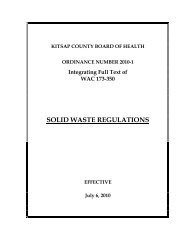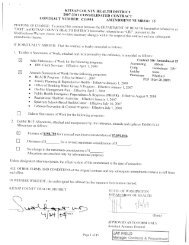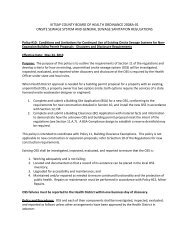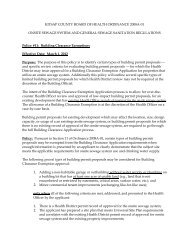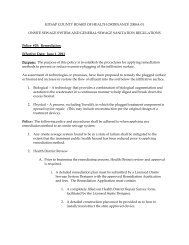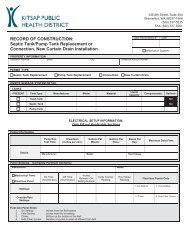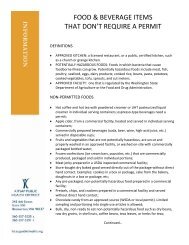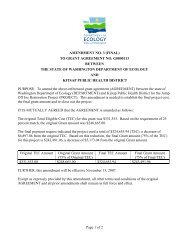Homeowner's Guide to Septic Systems - Kitsap Public Health District
Homeowner's Guide to Septic Systems - Kitsap Public Health District
Homeowner's Guide to Septic Systems - Kitsap Public Health District
Create successful ePaper yourself
Turn your PDF publications into a flip-book with our unique Google optimized e-Paper software.
<strong>to</strong><br />
<strong>Guide</strong> Homeowner’s<br />
<strong>Systems</strong><br />
Sewage Onsite
Property Information<br />
Site Address:<br />
Tax Parcel Number:<br />
Type of System:<br />
System Designer:<br />
System Installer:<br />
Date Installed:
Table of Contents<br />
Introduction 5<br />
What is an Onsite Sewage System? 6<br />
How does it all work?<br />
The <strong>Septic</strong> Tank 7<br />
Gravity Drainfi elds 8<br />
Pressure Distribution Drainfi elds 9<br />
Sand Based Media Treatment 10<br />
Aerobic Treatment Units 11<br />
Drip Irrigation 12<br />
Other Technologies 13<br />
How do I maintain my Onsite Sewage System? 14<br />
Operation & Maintenance 15<br />
Protecting your Onsite Sewage System 16<br />
Accessibility & Landscaping 17<br />
Additives and your Onsite Sewage System 18<br />
Onsite Sewage System Do’s 20<br />
Onsite Sewage System Dont’s 21<br />
What can make an Onsite Sewage System Fail? 22<br />
Warning Signs of a failing Onsite Sewage System 24<br />
Tips for repairing an Onsite Sewage System 25<br />
Other Onsite Sewage System Resources 26<br />
Onsite Sewage System Service Records 27
Developed by<br />
<strong>Kitsap</strong> <strong>Public</strong> <strong>Health</strong> <strong>District</strong><br />
Contributions include excerpts from:<br />
“A Homeowner’s <strong>Guide</strong> <strong>to</strong> <strong>Septic</strong> <strong>Systems</strong>”<br />
published by the<br />
United States Environmental Protection Agency<br />
Funded in part by<br />
SSWM<br />
KITSAP COUNTY<br />
Surface and S<strong>to</strong>rm Water Management<br />
Copyright <strong>Kitsap</strong> <strong>Public</strong> <strong>Health</strong> <strong>District</strong> - All rights reserved<br />
4
Introduction<br />
The intent of this booklet is <strong>to</strong> provide homeowners<br />
with basic information pertaining <strong>to</strong> onsite sewage<br />
systems; what they are, how they work, and how <strong>to</strong> take<br />
proper care of them.<br />
If after reading through this booklet you<br />
have questions or want more detailed<br />
information, please contact the <strong>Kitsap</strong><br />
<strong>Public</strong> <strong>Health</strong> <strong>District</strong> (KCHD) at<br />
(360) 337-5235, send us a note or come<br />
by and see us at 345 6th Street, Suite 300,<br />
Bremer<strong>to</strong>n, Washing<strong>to</strong>n, 98337.<br />
Protect your property investment,<br />
protect the environment,<br />
take good care of your onsite<br />
sewage system!<br />
“Striving <strong>to</strong> Make <strong>Kitsap</strong> County<br />
the <strong>Health</strong>iest Place on the Planet<br />
<strong>to</strong> Live, Work & Play.”<br />
5
What is an<br />
Onsite Sewage System<br />
An onsite sewage system (OSS) is also known as a septic system. OSS are<br />
designed <strong>to</strong> help prevent the spread of illness and disease by collecting,<br />
treating and dispersing wastewater from a home or business in<strong>to</strong> the<br />
native soils near a home or business.<br />
An OSS is typically made up of two or more components, or pieces, inked<br />
<strong>to</strong>gether with pipes. There are two general types of OSS available for<br />
use in Washing<strong>to</strong>n State; the unique site conditions for each individual<br />
lot (e.g., soil type and depth, size of lot, distance <strong>to</strong> surface waters<br />
and wells, etc.) determine which type of OSS can be installed. Different<br />
combinations of components may be used <strong>to</strong> best suit site conditions and<br />
owner preferences.<br />
General Types of OSS<br />
Standard Gravity OSS<br />
This is the most common type of system, and it generally has two main<br />
parts identifi ed as the <strong>Septic</strong> Tank & Drainfi eld (see page 8).<br />
Sometimes, a pump tank is also used in a standard system <strong>to</strong> transport<br />
the effl uent <strong>to</strong> a drainfi eld above the septic tank.<br />
Standard systems are required <strong>to</strong> be inspected at least once every 3<br />
years.<br />
Alternative OSS<br />
This type of system is required by state law where soil depth and/or<br />
other site conditions do not allow a standard gravity system <strong>to</strong> be used.<br />
In <strong>Kitsap</strong> County, alternative OSS are required <strong>to</strong> have annual operation<br />
& maintenance (O&M) (see page 15), and be inspected at least once<br />
per year.<br />
Pages 8-13 refer <strong>to</strong> some of the most common types of alternative<br />
systems.<br />
6
How does it all work?<br />
:: The <strong>Septic</strong> Tank ::<br />
Typically, the septic tank is a large, buried, rectangular or cylindrical<br />
container made of concrete, fi berglass, or polyethylene. Standard sizes<br />
range from 1,000 <strong>to</strong> 1,500 gallons.<br />
In Washing<strong>to</strong>n State, septic tanks are required <strong>to</strong> have two compartments,<br />
with access lids <strong>to</strong> each compartment for servicing and pumping.<br />
For most types of OSS, the septic tank is the core component. All of the<br />
wastewater from a home or business is routed <strong>to</strong> the septic tank for<br />
primary treatment. Primary treatment is a fi ltering process whereby<br />
heavy solids are allowed <strong>to</strong> settle-out, and fl oating solids are trapped,<br />
due <strong>to</strong> baffl es situated at the entrance and exit <strong>to</strong> each compartment of<br />
the septic tank.<br />
The result is clarifi ed effl uent that is more easily absorbed by native soils<br />
in the drainfi eld area. Adequate primary treatment is essential <strong>to</strong> protect<br />
drainfi elds and allow them <strong>to</strong> function properly.<br />
Main Access Lid<br />
Riser <strong>to</strong> Surface<br />
All liquid<br />
waste from<br />
home<br />
To next<br />
Component<br />
Scum Layer<br />
C<br />
enter<br />
W<br />
all<br />
Inlet<br />
Baffl e<br />
1st Compartment<br />
Clear Zone<br />
2nd Compartment<br />
Clear Zone<br />
Effl uent<br />
Filter<br />
Sludge Layer<br />
Outlet<br />
Baffl e
How does it all work?<br />
:: Gravity Drainfields ::<br />
Gravity Drainfi elds are an onsite sewage system component made up of<br />
a network of pipes and/or other materials placed in trenches <strong>to</strong> distribute<br />
effl uent in<strong>to</strong> the soil. All OSS have some type of soil dispersal component.<br />
The size and type of the<br />
drainfi eld depends upon the<br />
estimated daily wastewater<br />
quantity and soil type.<br />
Gravity Distribution<br />
All liquid waste<br />
from home<br />
• Provides fi nal treatment and dispersal<br />
of effl uent in conjunction with native<br />
soils.<br />
• Relies on unsaturated and uncompacted<br />
soils <strong>to</strong> function properly.<br />
• Trenches are installed level and run<br />
parallel <strong>to</strong> the natural con<strong>to</strong>urs of<br />
the land.<br />
• Uses equal or serial distribution <strong>to</strong><br />
load effl uent in<strong>to</strong> the soil.<br />
• Should have a designated backup<br />
replacement area for future use.<br />
Clean-out<br />
(outside home)<br />
<strong>Septic</strong> Tank<br />
Access Riser<br />
Effl uent Filter Access<br />
Distribution-box<br />
Moni<strong>to</strong>ring<br />
Port<br />
100% Reserve<br />
Drainfi eld Area<br />
Gravel-Less<br />
Drainfi eld<br />
8
How does it all work?<br />
:: Pressure Distribution Drainfields ::<br />
Pressure Distribution <strong>Systems</strong> consist of a septic tank, pump tank and<br />
drainfi eld. The pump tank contains a pump, pump control fl oats and a<br />
high water alarm fl oat. Pressure distribution systems rely on a pump <strong>to</strong><br />
distribute effl uent evenly through pressurized lines rather than just gravity,<br />
so the effl uent is dispersed<br />
over the entire<br />
Pressure Distribution drainfi eld each time the<br />
pump runs.<br />
• Time dosed effl uent distribution <strong>to</strong><br />
the entire drainfi eld area.<br />
• Provides a higher level of treatment<br />
<strong>to</strong> effl uent, as compared <strong>to</strong> a standard<br />
gravity OSS.<br />
• Protects the drainfi eld from being<br />
overused (high water use) as a<br />
result of the time dosing of the<br />
drainfi eld.<br />
• Requires an annual Operation &<br />
Maintenance contract which includes at<br />
least one inspection of the onsite<br />
sewage system.<br />
Access Risers<br />
Clean-out<br />
(outside home)<br />
All liquid waste<br />
from home<br />
Pressure Line<br />
Control Valve<br />
Moni<strong>to</strong>ring<br />
Port<br />
<strong>Septic</strong> Tank<br />
Pump Tank<br />
Clean-out<br />
Gravel-Less<br />
Drainfi eld<br />
100% Reserve<br />
Drainfi eld Area<br />
9
How does it all work?<br />
:: Sand Based Media Treatment ::<br />
Sand Based Media Treatment <strong>Systems</strong> consist of a septic tank, pump<br />
tank, sand fi lter and drainfi eld (or sand-lined trenches). Sand fi lter OSS<br />
use pressure distribution technology through special sand <strong>to</strong> achieve a<br />
very high level of effl uent<br />
treatment, before effl uent is<br />
distributed <strong>to</strong> the drainfi eld.<br />
Sand Based Treatment<br />
All liquid waste<br />
from home<br />
Clean-out<br />
(outside home)<br />
• Typically used where site conditions<br />
require a higher level of effl uent<br />
treatment <strong>to</strong> protect wells, surface<br />
water or shallow ground waters.<br />
• Pre-treats the effl uent with air prior<br />
<strong>to</strong> release <strong>to</strong> the drainfi eld.<br />
• Can be constructed above or below<br />
the ground.<br />
• Requires an annual Operation &<br />
Maintenance contract which includes<br />
at least one inspection of the OSS.<br />
Access Risers<br />
<strong>Septic</strong> Tank<br />
Pressure Line<br />
Clean-out<br />
Pump Tank<br />
Sand Filter<br />
Moni<strong>to</strong>ring<br />
Port<br />
10<br />
Control Valves<br />
100% Reserve<br />
Drainfi eld Area<br />
Gravel-Less<br />
Drainfi eld<br />
Clean-out
How does it all work?<br />
:: Aerobic Treatment Units ::<br />
Aerobic Treatment Unit (ATU) <strong>Systems</strong> also rely on pre-treatment <strong>to</strong> clean<br />
effl uent before it is sent <strong>to</strong> the drainfi eld.<br />
An ATU OSS consists of an ATU component (there are many kinds) instead<br />
of, or in addition <strong>to</strong>, a septic tank and a drainfi eld.<br />
Aerobic Treatment Units<br />
• Typically used where site conditions<br />
require a higher level of effl uent<br />
treatment <strong>to</strong> protect wells, surface<br />
water or shallow ground waters.<br />
• Uses air <strong>to</strong> speed up the normal<br />
waste water treatment process.<br />
• May utilize any type of drainfi eld<br />
system (equal, serial or pressure<br />
distribution, or drip).<br />
• Requires an annual Operation &<br />
Maintenance contract which includes<br />
at least one inspection of the OSS.<br />
Access Risers<br />
For onsite sewage systems<br />
approved after July 1,<br />
2007, it will be common<br />
<strong>to</strong> have a pressure distribution<br />
or drip irrigation<br />
drainfi eld following the<br />
ATU component.<br />
All liquid waste<br />
from home<br />
Clean-out<br />
(outside home)<br />
Moni<strong>to</strong>ring<br />
Port<br />
Distribution-box<br />
<strong>Septic</strong> Tank<br />
Aerobic Treatment<br />
Unit (ATU)<br />
Gravel-Less<br />
Drainfi eld<br />
100% Reserve<br />
Drainfi eld Area<br />
11
How does it all work?<br />
:: Drip Irrigation ::<br />
Drip Irrigation Dispersal <strong>Systems</strong> utilize a series of pressurized drip lines<br />
(much like the ones used for plant irrigation) located just below the<br />
surface of the ground. Like some of the other alternative OSS, drip<br />
irrigation uses pre-treatment, time dosing, and pressure distribution<br />
<strong>to</strong> attain high levels of<br />
effl uent treatment.<br />
Drip irrigation is ideal<br />
for use in shallow soils.<br />
Drip Irrigation<br />
• Best used with ATU or sand fi lter<br />
pre-treatment technologies.<br />
• Can be used in shallow soils.<br />
• Requires less area than the typical<br />
drainfi eld.<br />
• Can be routed around site constraints<br />
such as buildings, gardens, etc.<br />
• Requires an annual Operation &<br />
Maintenance contract which includes<br />
at least one inspection of the OSS.<br />
All liquid waste<br />
from home<br />
Clean-out<br />
(outside home)<br />
Access Risers<br />
Particle<br />
Filter<br />
<strong>Septic</strong> Tank<br />
Drip Return Line<br />
Aerobic Treatment<br />
Unit (ATU)<br />
Pump Tank<br />
Water<br />
Meter<br />
12<br />
100% Reserve<br />
Drainfi eld Area<br />
Drip Irrigation<br />
Drainfi eld
How does it all work?<br />
:: Other Technologies ::<br />
There are many new and emerging OSS technologies becoming<br />
available <strong>to</strong> help property owners mesh regula<strong>to</strong>ry requirements, site<br />
conditions, and budgets.<br />
A common treatment and disposal technology found in <strong>Kitsap</strong> County is<br />
the Glendon ®<br />
BioFilter System. It consists of a septic tank, pump tank, and<br />
a “containerized” drainfi eld<br />
system. This OSS treats the<br />
Glendon ®<br />
BioFilters effl uent before fi nal<br />
dispersal in the surrounding<br />
soil. Time dosing is utilized<br />
• Provides high level of effl uent<br />
treatment.<br />
like pressure distribution<br />
• Can be installed in shallow soil. and sand fi lters.<br />
• Requires an annual Operation &<br />
Maintenance contract which<br />
includes at least one inspection of<br />
the OSS.<br />
Clean-out<br />
(outside home)<br />
All liquid waste<br />
from home<br />
*Typical 1 Pod per bedroom<br />
Access Risers<br />
Control Valves<br />
<strong>Septic</strong> Tank<br />
Pump Tank<br />
Glendon ®<br />
BioFlter*<br />
100% Reserve<br />
Drainfi eld Area<br />
13
How do I maintain my<br />
Onsite sewage system?<br />
<strong>Septic</strong> Tanks<br />
Replacing your system<br />
<strong>Septic</strong> tanks need <strong>to</strong> be<br />
is very costly.<br />
inspected at least every 3<br />
years and pumped as needed<br />
Extend the life of your<br />
<strong>to</strong> prevent solids from damaging<br />
the drainfi eld. Solids and<br />
Onsite Sewage System!<br />
scum not decomposed remain<br />
in the tank. If not removed, solids or scum may eventually overfl ow in<strong>to</strong><br />
the drainfi eld and damage it.<br />
Additive products are not necessary and may harm the system.<br />
Access <strong>to</strong> the tank is important for regular pumping & maintenance. For<br />
easy access a riser* is recommended and is required on some systems.<br />
Drainfields<br />
• Route or direct surface and ground water away from the system<br />
<strong>to</strong> prevent fl ooding.<br />
• Limit use of chemicals and garbage disposals.<br />
• Prevent physical damage from<br />
driving, parking, building,<br />
burning, lives<strong>to</strong>ck pasturing and<br />
sprinkler systems.<br />
* A riser provides surface access <strong>to</strong> tanks buried<br />
below the surface by providing access <strong>to</strong><br />
the tank as an extension of the opening.<br />
14
Operation & Maintenance<br />
:: Alternative Onsite Sewage <strong>Systems</strong> ::<br />
Alternative OSS require an Operation & Maintenance (O&M)<br />
contract which includes at least one inspection of the OSS per year by a<br />
certifi ed maintenance service provider.<br />
What is the Operation & Maintenance Program About?<br />
This program is a state and locally mandated program created <strong>to</strong> keep<br />
your OSS working properly and surrounding environment healthy. This<br />
regulation benefi ts OSS owners by:<br />
• Protecting your property investment from premature<br />
failure. Your OSS is a critical part of your home.<br />
• Saving you money: replacing a failed OSS can<br />
cost tens of thousands of dollars.<br />
• Protecting your family, environment and community<br />
from raw sewage spills.<br />
• Providing you assurance: much like a yearly health<br />
check-up or car maintenance, both essential <strong>to</strong> our<br />
everyday needs.<br />
Effl uent<br />
fi lters must<br />
be cleaned<br />
annually at<br />
a minimum <strong>to</strong><br />
prevent costly and<br />
unhealthy backups<br />
in<strong>to</strong> the home.<br />
Effl uent fi lters may be<br />
found on both standard<br />
gravity and alternative<br />
onsite sewage systems.<br />
The O&M contract<br />
and inspection<br />
program promotes<br />
regular maintenance<br />
of your OSS and<br />
provides educational<br />
opportunities.<br />
15
Protecting Your<br />
Onsite Sewage System<br />
Watch what goes down the drain<br />
• Keep grease, hair, and food scraps from going down the drain.<br />
• Don’t fl ush diapers, plastics, paper <strong>to</strong>wels, cigarettes,<br />
personal hygiene products or kitty litter down the <strong>to</strong>ilet.<br />
• Don’t use a garbage disposal.<br />
• Don’t use au<strong>to</strong>matic <strong>to</strong>ilet bowl cleaner or deodorizers.<br />
• Don’t use excessive strong drain cleaners (e.g., Draino)<br />
or other chemicals.<br />
Use concentrated liquid detergents<br />
• Do not overuse detergents.<br />
• Minimize use of liquid fabric softeners or use dryer sheets instead.<br />
• Fillers in some powdered detergents can clog pipes.<br />
Don’t drown the drainfield<br />
• Fix leaky fi xtures and <strong>to</strong>ilets.<br />
• Conserve water.<br />
• Spread out laundry throughout the week -<br />
try <strong>to</strong> do no more than two loads in one day.<br />
• Divert surface waters and downspouts away from the drainfi eld.<br />
Know where you stand<br />
• Find out where the on-site sewage system is located so that<br />
you can avoid driving, digging, or parking on it.<br />
• Request your as-built (OSS records) from KCHD.<br />
Clean out access<br />
• Located between the house and tank (capped pipe).<br />
It is available for unblocking a clogged line.<br />
Don’t poison the system<br />
• Never pour products labeled “danger” or “poison” down<br />
the drain. Take unwanted hazardous products <strong>to</strong> the Moderate<br />
Risk Waste Facility (360) 337-5777.<br />
• Minimize use of strong chemicals like bleach and drain cleaners.<br />
16
Accessibility & Landscaping<br />
Easy access <strong>to</strong> OSS components<br />
• Know it’s location.<br />
• Retrofi t older systems with<br />
risers for easier access.<br />
• Use moveable markers (such<br />
as: planters, benches,<br />
sculptures) <strong>to</strong> cover system<br />
ports that need regular<br />
inspection.<br />
• Keep your as-built handy<br />
(a copy of the as-built is<br />
available at the <strong>Health</strong> <strong>District</strong>).<br />
Landscaping your OSS<br />
• Planting is recommended <strong>to</strong><br />
help with oxygenation &<br />
evaporation.<br />
• Consider drought resistant<br />
plants.<br />
• Choose plants that are<br />
non-invasive and are not<br />
deep rooting.<br />
• Grasses are recommended.<br />
• Consult with your local nursery,<br />
landscaping professional or<br />
the Washing<strong>to</strong>n State<br />
Cooperative Extension<br />
Master Gardeners<br />
17
Additives and your<br />
Do I need <strong>to</strong> put additives in my<br />
septic system <strong>to</strong> keep it working properly?<br />
The <strong>Kitsap</strong> <strong>Public</strong> <strong>Health</strong> <strong>District</strong> and most engineers/sanitation<br />
professionals believe that commercial septic system<br />
additives are not effective (even potentially<br />
harmful) <strong>to</strong> an onsite sewage system.<br />
The reasons for this include:<br />
• No known additives can reduce solids<br />
suffi ciently <strong>to</strong> make pumping unnecessary.<br />
• Household wastewater contains an abundant<br />
supply of microorganisms that provide for the<br />
proper functioning of your system.<br />
• Some additives cause problems with<br />
the drainfi eld.<br />
If you are currently using an additive and<br />
would like more information about approved<br />
additives*, please contact KPHD.<br />
* Product approval by the Washing<strong>to</strong>n Department of <strong>Health</strong><br />
merely indicates that the ingredients are unlikely <strong>to</strong> cause harm<br />
<strong>to</strong> public health or water quality. It does not however, substantiate<br />
the performance claimed by additive manufacturers.<br />
18
Onsite Sewage System<br />
Don’t be fooled!<br />
“Additives are costly<br />
and unnecessary.”<br />
19
Do’s<br />
Onsite Sewage <strong>Systems</strong><br />
Know where your OSS is located and protect it:<br />
• Have a copy of your as-built or map location of all septic<br />
parts (request a copy from the <strong>Health</strong> <strong>District</strong>).<br />
• Pass along all records & information <strong>to</strong> new<br />
owners or tenants of property.<br />
• Save funds <strong>to</strong> cover future<br />
maintenance or repair costs.<br />
• Educate your family,<br />
guests or renters.<br />
Inspect your OSS yearly:<br />
• Keep accurate, detailed records of<br />
any repairs & pumping.<br />
Use water wisely:<br />
• Conserve water – use low fl ow fi xtures, spread<br />
laundry throughout the week, limit shower length,<br />
fi x any leaks promptly.<br />
• Direct runoff from roofs, streets, driveways & adjoining<br />
properties away from sewage system area.<br />
• Keep any irrigation (sprinkler) system at least 10 feet<br />
from the edge of the on-site sewage system.<br />
• Drain water from hot tubs & water softeners away<br />
from drainfi eld, s<strong>to</strong>rm drains & surface waters.<br />
20
Onsite Sewage <strong>Systems</strong><br />
Dont’s<br />
Compact soils of drainfield or reserve area in any way by:<br />
• Driving/parking vehicles or heavy equipment<br />
(including boats) in the OSS area.<br />
Disturb the drainfield or reserve area by:<br />
• Pasturing lives<strong>to</strong>ck, building structures, or burning in the area.<br />
• Covering it with impervious landscaping materials.<br />
• Driving across, grading, leveling, fi lling or cutting the area.<br />
• Installing a sprinkler system or planting deep-rooted<br />
water-loving plants over the drainfi eld.<br />
Overload the system by:<br />
• Using <strong>to</strong>o much water.<br />
• Using a garbage disposal.<br />
• Using tank additives or “miracle” septic system cleaners.<br />
• Discarding medications down the drain.<br />
• Allowing backwash from water softeners or conditioners.<br />
• Pouring strong household cleaning products down the drain.<br />
“You are the key<br />
<strong>to</strong> water quality.”<br />
21
What can make an<br />
Onsite Sewage System Fail?<br />
If the amount of wastewater entering your onsite sewage system is more<br />
than the system can handle, the wastewater may back up in<strong>to</strong> the house<br />
or yard and create a health hazard.<br />
You can suspect a system failure not only when a foul odor is emitted but<br />
also when partially treated wastewater fl ows up <strong>to</strong> the ground surface;<br />
however, by the time you can see a gray/black substance or smell<br />
sewage odors the damage might already be done.<br />
Limiting your water use will reduce the amount of wastewater your onsite<br />
sewage system must treat. When you have your system inspected and<br />
pumped as needed, you reduce the likelihood of system failure.<br />
A system installed in unsuitable soils can also fail. Other failure risks<br />
include tanks that are inaccessible for maintenance, drainfi elds that are<br />
paved or parked upon and tree roots or defective components that interfere<br />
with the treatment process.<br />
Toxics:<br />
Household <strong>to</strong>xics can lead <strong>to</strong> the<br />
premature failure of your onsite sewage system. Does someone use the<br />
utility sink <strong>to</strong> clean out paint rollers or fl ush <strong>to</strong>xic cleaners? Oil-based<br />
paints, solvents and large volumes of <strong>to</strong>xic cleaners should not enter your<br />
septic system. Remember that your septic system contains living organisms<br />
that digest and treat waste.<br />
22
What can make an<br />
Onsite Sewage System Fail?<br />
Cleaning Products:<br />
For the most part, your onsite sewage system’s bacteria should recover<br />
quickly after small amounts of household cleaning products have been<br />
introduced <strong>to</strong> the waste stream. Of course, some cleaning products are<br />
less <strong>to</strong>xic <strong>to</strong> your onsite sewage<br />
system than others.<br />
Hot Tubs/Swimming Pools:<br />
Hot tubs are a great way <strong>to</strong> relax, unfortunately your onsite sewage<br />
system was not designed <strong>to</strong> handle large quantities of water from your<br />
hot tub. Emptying large amounts of water in<strong>to</strong> your onsite sewage system<br />
stirs the solids in the tank and pushes them out in<strong>to</strong> the drainfi eld, causing<br />
it <strong>to</strong> clog and fail. Draining your hot tub in<strong>to</strong> your onsite sewage system<br />
or over the drainfi eld area can overload the system and cause it <strong>to</strong> fail.<br />
Garbage Disposals:<br />
Eliminating or reducing the use of a garbage disposal can reduce the<br />
amount of grease and solids entering the onsite sewage system which<br />
can possibly clog the drainfi eld. A garbage disposal grinds up kitchen<br />
scraps, suspends them in water, and sends the mixture <strong>to</strong> the septic tank.<br />
Once in the septic tank, some of the materials are broken down by<br />
bacterial action, but most of the grindings have <strong>to</strong> be pumped out of the<br />
tank. Using a garbage disposal frequently can signifi cantly increase the<br />
accumulation of sludge and scum in your tank resulting in the need for<br />
more frequent pumping.<br />
23
Warning signs of a failing<br />
Onsite Sewage System<br />
• Sewage on the surface of the ground or<br />
discharging in<strong>to</strong> surface waters.<br />
• A foul smelling, slimy, blackish/greyish<br />
liquid in the drainfi eld area or out of<br />
down-slope pipes or banks.<br />
• Standing/fl owing water or soggy soils in<br />
drainfi eld area.<br />
• Greywater (laundry or sink water)<br />
discharge <strong>to</strong> the ground or surface waters.<br />
• Sewage back-up in<strong>to</strong> residence caused by<br />
slow soil absorption.<br />
! WARNING!<br />
24
Tips for repairing an<br />
Onsite Sewage System<br />
• Repairs require <strong>Health</strong> <strong>District</strong> review<br />
or permit.<br />
• Consult a repair professional <strong>to</strong> properly<br />
diagnose system failure.<br />
• Don’t assume that a <strong>to</strong>tal sewage system<br />
replacement is needed.<br />
• A certifi ed OSS designer, installer or<br />
operation and maintenance contrac<strong>to</strong>r is<br />
trained <strong>to</strong> diagnose the problem that<br />
caused the failure.<br />
• Pumping a failing system is only a<br />
temporary solution.<br />
• While it may be necessary <strong>to</strong> have the<br />
tank pumped during the repair process,<br />
pumping the tank alone will not correct<br />
a failing OSS.<br />
• Stay in contact with the <strong>Health</strong> <strong>District</strong>.<br />
• Technical assistance is available<br />
<strong>to</strong> help you determine the<br />
best solution(s) for your<br />
situation.<br />
25
Other OSS Resources<br />
Websites<br />
www.kitsappublichealth.org<br />
<strong>Kitsap</strong> <strong>Public</strong> <strong>Health</strong> <strong>District</strong><br />
Environmental <strong>Health</strong> Division<br />
345 6th Street, Suite #300<br />
Bremer<strong>to</strong>n, WA 98337-1866<br />
(360) 337– 5285<br />
www.dol.wa.gov<br />
WA State Department of Licensing<br />
To fi nd out if your designer/engineer is<br />
authorized <strong>to</strong> provide design services.<br />
www.wsg.washing<strong>to</strong>n.edu<br />
Washing<strong>to</strong>n Sea Grant Program<br />
(360) 427-9670 x 437,<br />
(360) 275-4467 x 437<br />
Click on <strong>Septic</strong> Sense<br />
for information regarding<br />
onsite sewage systems.<br />
www.doh.wa.gov<br />
WA State Department of <strong>Health</strong><br />
Search for “Wastewater”<br />
26
OSS Service Records<br />
Date:<br />
Contrac<strong>to</strong>r Name/Work Done:<br />
27



